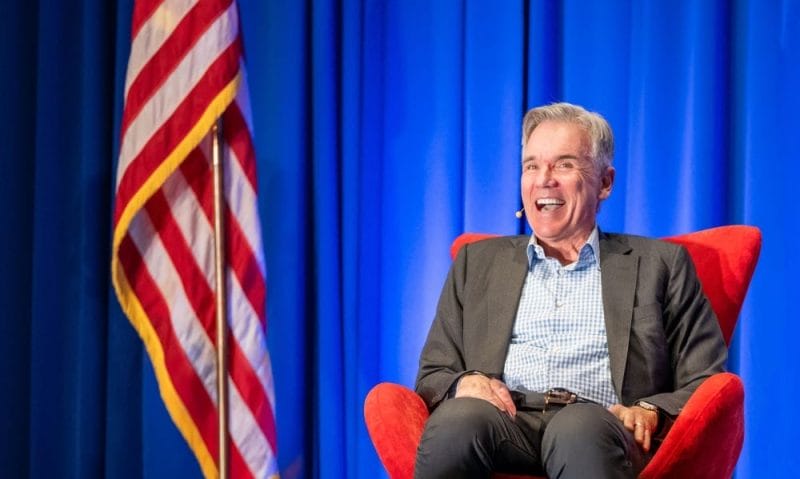
Daymond John is not an IT mogul, but there’s no doubt that as one of ABC’s “Shark Tank” investors, he knows what it takes to start a company from nothing and grow it to massive success. Born in Brooklyn and raised in Queens by a single mom who worked three jobs to put food on the table, no one can say John had any special advantages as a kid. After his dad left when he was just 10 years old, John believed he had to step up and be the man of the house.
To earn money, he’d hand out flyers for $2.25 an hour at a local mall, and when he returned home, he would save all the money he earned. He decided he wanted to start his own clothing company, a goal that seemed like a pipe dream for a young, inexperienced, dyslexic, broke “wantra-preneur” like John. However, his tenacity and hard work paid off, and his clothing line, FUBU, grew to a $6 billion brand that was worn by prominent artists from LL Cool J to *NSYNC. Today, John is a three-time bestselling author, investor, and CEO of The Shark Group, a branding and consulting firm.
His experiences have given him the expertise to identify integral components of long-term success in his life, career, and the years he’s spent growing as an entrepreneur and a person. John recently shared his five key SHARK points with Robin Robins and an exclusive group of her Tennessee-based marketing company, Technology Marketing Toolkit, Inc. These SHARK points serve as a template to keep you motivated, driven, and on track — just as John needed when he launched his global brand. “I had a lot of failures, but my hustle, my desire, my drive got me where I am,” John said. And these five principles guided that push.
S – SET A GOAL
As a teenager, John worked for small-business owners at the Coliseum Mall in Queens. These local entrepreneurs were his first examples of the drive and hustle required to make a name for yourself. They weren’t the greedy, rude business owners who were being depicted on famous TV shows like “Dallas” or “The Simpsons.” The entrepreneurs John worked for were real people who worked tirelessly every day for their goals and valued the community where they had set those goals. “They were the first to the office, the last to leave,” he recalled. “They thanked everyone for their success, but they blamed only themselves for their failures. They were mentors in the community. They were always educating themselves.
They were amazing people.” In the same mall where John once handed out flyers, he learned what his own entrepreneurial aspirations could become. While John had cultivated a sense of entrepreneurship from a young age, his sense of what he wanted to do crystallized at a 1986 concert at the Spectrum Theater in Philadelphia. As Run-DMC took the stage, John’s chief passions, business and hip-hop, fused together in his mind to provide a blueprint for the years to come. “In that split second, my life turned from black and white into Technicolor,” John said. “I understood, in that moment, that no matter what, I was going to live, die, and prosper in this world of hip-hop.” As Run-DMC played, kids in the crowd were holding up pairs of their Adidas sneakers. John realized there was money to be made creating clothes specifically for the growing community of people who identified with hip-hop.
He set 10 goals that night. Six of them expired in three months, while the others expired at two, five, 10, and 20 years. He thought about those goals every night and took a step toward one of them every day. It’s a practice he continues to this day. “You can’t hit a target you can’t see,” John said. “If you aren’t in control of the goals you set, you let other people set goals for you.”
H – HOMEWORK
John was already devoted to hip-hop. How could he not be, growing up in the city where the genre was born and living in the same neighborhood as some of its earliest heroes, like LL Cool J and Run-DMC? In a sense, John had been gathering data on his market demographic his entire life by immersing himself in the hip-hop culture. But John had to find a way to fit the lifestyle he and his friends were emulating in the streets of New York into that Technicolor vision he saw at Run-DMC’s concert. Hip-hop had found a way to create a culture from hundreds of people dancing all night with music blasting from speakers with stolen electricity into a movement that was now encapsulating thousands of people. Suddenly, John had people to look up to who weren’t the “pimps and drug dealers” driving fancy cars outside his doors. “Through this music, the kids were communicating about their hopes, their dreams, their loves, their aspirations,” he said. “Hip-hop wasn’t something that you just listened to; it was a way to live.”
He began broadening his understanding by studying the fashion brands adored by his peers but realized that many brands had unspoken disdain for the people who were buying their products. One of them, Timberland, even went so far as to put an ad in the New York Times declaring they didn’t sell or make their boots for “drug dealers.” John was incensed. He was working two jobs, having picked up a second at Red Lobster, in order to buy things like Timberland boots, because his homework told him those were the boots his hip-hop heroes wore. But those same boots on his feet were sold by a company that was calling him and his community criminals. “Who’s ever going to support, love, and value the customer who’s purchasing their goods?” he thought. Well, he was. “I’m going to come up with a name; it’s going to be four letters,” he decided. “It’s not going to be about a color, because I’m not going to be a bigot the same way Timberland is; it’s going to be about a culture.” He went home and created a shirt and hat emblazoned with the letters BUFU: By Us, For Us. A few days later, John flipped the letters to FUBU, and a business was born. John’s lifelong homework came in handy when it came to marketing FUBU on a shoestring budget, and his love for the business he was creating is what propelled it forward. He’d show up at video shoots and convince rappers to wear his FUBU clothing.
He asked business owners in large cities if he could remove the graffiti on their storm gates and paint them white, slapping an “Authorized FUBU Dealer” stencil on them, making FUBU familiar to anyone who walked, drove, or rode by after hours. He harangued hip-hop’s biggest star, LL Cool J, for a promotional photo, making him the company’s first spokesperson. He found out about the MAGIC show, an industry event where he could launch FUBU on a wide scale. He and his partners didn’t even have a booth when they arrived, but they left with $300,000 in orders. The thing is, he didn’t have $300,000 to spend on creating these orders. Instead, he turned to the woman who had been his business partner since he was 6 years old when he was selling pencils to the kids at school: his mom, or Ms. John, as she likes to be known publicly. She was able to acquire a $100,000 loan against their $75,000 house, and John and his business partners funneled that loan and the money they had made at the tradeshow into creating a makeshift sewing operation in their home.
They would sleep in sleeping bags on the ground, clothes were stacked to the ceiling, and by the end of it all, there was only $500 left in the bank. Again, John had a problem. He was lacking the financial savvy he needed to get the clothes out the door before his money ran dry. And, again, his mom stepped up. She asked him to save $2,000 from his job at Red Lobster, and then she would help him out. When he handed her the $2,000, Ms. John placed an advertisement in the local newspaper that read, “$1 million in orders — need financing.” That ad generated 33 calls offering help. Three of them were legitimate, and one was Samsung’s textile’s division. With backing from Samsung, FUBU sold $300 million worth of products in just three months. As FUBU continued to grow, John kept studying and fueling his passion. He learned about distribution, manufacturing, staffing, and everything else required for functioning as a multimillion-dollar brand. As FUBU took off, so did John’s celebrity in the rap industry. His homework was paying off.
A – AMORÉ
For John, sleeping in a sleeping bag next to a sewing machine didn’t feel like sacrifice. Learning new skills and doing his homework was never a problem. Waking up at 6 a.m., sewing, selling his shirts, working at Red Lobster until midnight, and sewing again until 2 a.m. never felt like work. All of the challenges he faced were surmountable because his passion never waned, and his brand grew because of it. “The single thing that every successful person I’ve ever met has in common is amoré, love,” John said. “I would’ve dressed people for free for the rest of my life.” No matter how big FUBU grew, John believed his love for the business would grow with it, and FUBU was on the cusp of booming.
Years later, LL Cool J would covertly rap about FUBU in a Gap ad while wearing a FUBU hat. The company’s advertising team was targeting the market that LL and his hip-hop partners had built, but they never caught the subtle mention by LL before airing the advertisement. The hip-hop community would flock to Gap stores because they believed LL was telling them they could purchase FUBU clothing at Gap, only to leave without purchasing anything in search of FUBU elsewhere, John explained. After Gap’s fiasco, FUBU would grow even larger than it had after Samsung’s backing. Suddenly, John had made it big time, and his personal celebrity star was rising. He wasn’t just this up-and-coming kid from Queens in the hip-hop world anymore. He was Daymond John, and he was living in Asia for six months, Europe the next six, and partying every day with rappers in between — rappers who weren’t even wearing FUBU anymore. (Ironically, they were wearing another clothing brand John owned.) But this didn’t matter to his family.
Fast forward a few years, and John was married with two little girls, Yasmeen and Destiny. Yet, the family rarely saw him. Instead, he was turning into the father who had left him at 10. His wife was stuck taking care of the family’s eight houses and two daughters with nobody to talk to. Eventually, she had enough and filed for divorce. “I remember my ex-wife calling me up and saying, ‘I didn’t leave because I don’t love you; I left because I do love you,” John said. He had a stark realization that he had lost himself and the love FUBU was built on. The guiding principles he believed in were no longer a part of his life, and the love he had for his business had turned toxic. His ex-wife insisted he stop his self-destructive actions and instead talk to other entrepreneurs and funnel that passion and desire that was once so bright into something that was useful beyond FUBU.
“She kicked me in my ass,” he said. John discovered that his focus was on the celebrity his brand was creating for him, and his initial love was getting lost in the shuffle. As his daughters grew, he was parenting them over the phone half a world away, dazed and hungover from a night of partying. His love had shifted from the goals and passion he had years prior as a young adult, and this time, John took his ex-wife’s harsh reminder to heart. “You’re not setting goals,” he told himself. “You’re out drinking and partying; that’s not setting goals. You’re not doing your homework. A hot fashion brand lasts 5–7 years. And amoré, love, do you love not seeing your daughters?”
R – REMEMBER, YOU ARE THE BRAND
In redefining himself and discovering a new path, John learned that the way he was living his FUBU lifestyle wasn’t representative of who he needed to be. Sure, the hip-hop stars who were wearing his clothes were partying until 6 a.m. In fact, FUBU stood for “For Us, By Us,” and he was living the lifestyle that the movement, which began in the streets, had developed. But that’s where his growth stopped, and while the movement grew into new clothing and styles, John was stuck repeating the “work hard, party harder” lifestyle. He took the tough love from his ex-wife, shifted his focus, and began working on a better version of himself to transform his life. The rap stars he once partied with were replaced with morning TV hosts and entrepreneurs working through the early vision of their business.
When reality TV show producer Mark Burnett saw John speaking on shows like CNBC, he thought John would be a good fit for a little show he was developing called “Shark Tank.” By the time he joined the “Shark Tank” team, John had learned a valuable lesson on vision. Instead of investing his lifestyle and work into the moment, John learned how he could influence the future, and it started with the budding business owners he met on “Shark Tank.” “We don’t invest in brands,” he said of his experience on “Shark Tank.” “We invest in people. That’s the most important thing.”
John proposed that people should brand themselves with just 2–5 words. Those words will shape who you are and your goals at that moment, and as he was discovering what his personal brand was again and the value of investing in people on “Shark Tank,” he was living by the motto, “I’m on a quest.” Those four words rang true for John, as he was hustling at a higher level than ever before. This time, as his success grew, he expanded into industries he never even thought about before. His quest was partnering with real people, becoming synonymous with success, and celebrating the achievements of those he mentored. With his newest sense of who he was and who he could be, John understood that he could communicate his value, and he began looking at others that same way. “Any time you take a picture or post a selfie, your brand is being represented, and those 2–5 words are in there,” John said. His brand was rising and getting stronger by the day. Nothing could stop him.
K – KEEP SWIMMING
On Good Friday 2017, something almost did bring John’s latest growth to a halt, and John’s definition of his life would be boiled down into a new set of 2–5 words. That morning, he was admitted to the hospital for a simple hour-long procedure to remove a growth on his thyroid. Before being put under, the anesthesiologist asked John to think about what true success means to him. If he could think about his future, including his new daughter, the doctor told him, he would win before the surgery even began. That surgery turned into a three-hour ordeal in which doctors removed a stage-2 cancerous growth that was set to overtake his lymph nodes and his brain. That day, his 2–5-word motto turned from “I’m on a quest” to “My health is first,” John said.
“When I was under, I knew I was going to beat this thing because I was going to be here to be around my fellow sharks and walk my three beautiful girls down the aisle. Because you know what we do as sharks?” he asked. “We always just keep swimming.” John’s life has been a series of obstacles that could have prevented him from building his empire. He didn’t let his father’s absence, dwindling bank account, and spiraling while FUBU soared stop him from achieving the goals that kid at Run-DMC set out to do. And on that operating table, John was facing another obstacle that threatened to sink him.
Instead, John kept swimming.
Business and life are full of hurdles, and there are times when we want to pack it up and call it a day. We can’t. If we want to reach new heights, we must have persistence, determination, and a ceaseless attitude of progress. We may not all be sharks on TV, but we can all learn to swim like one.
If you would like to see more, visit MSPsuccessmagazine.com/john to see his exclusive interview with Technology Marketing Toolkit Founder and CEO, Robin Robins.















